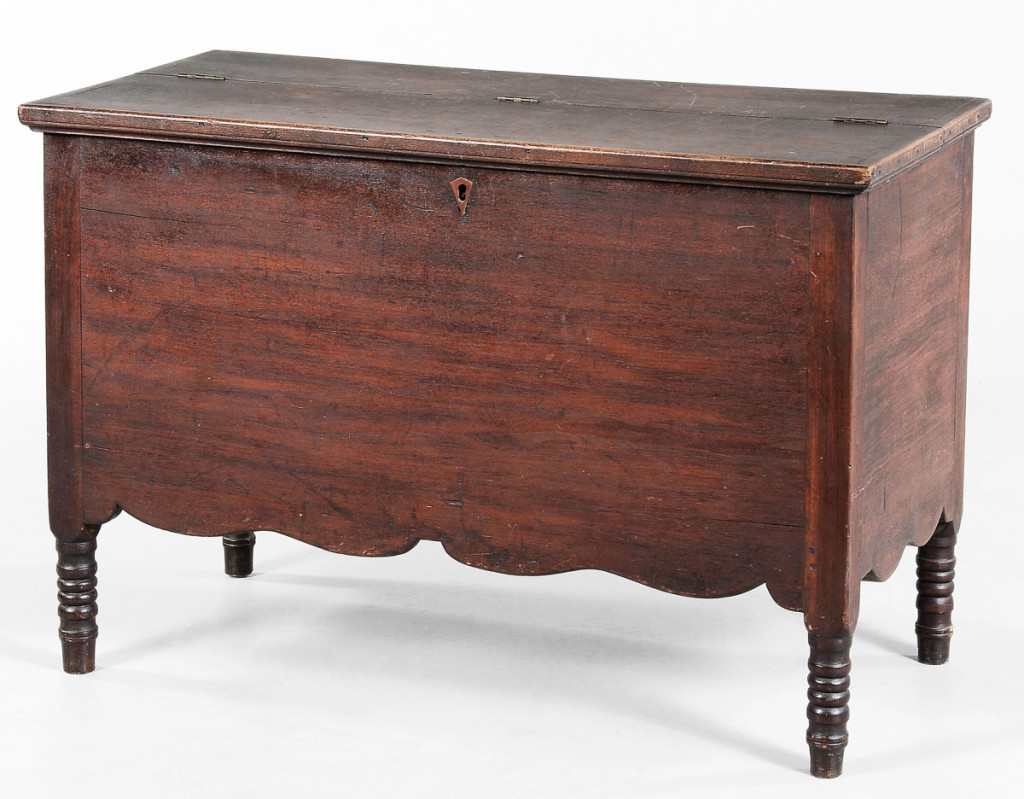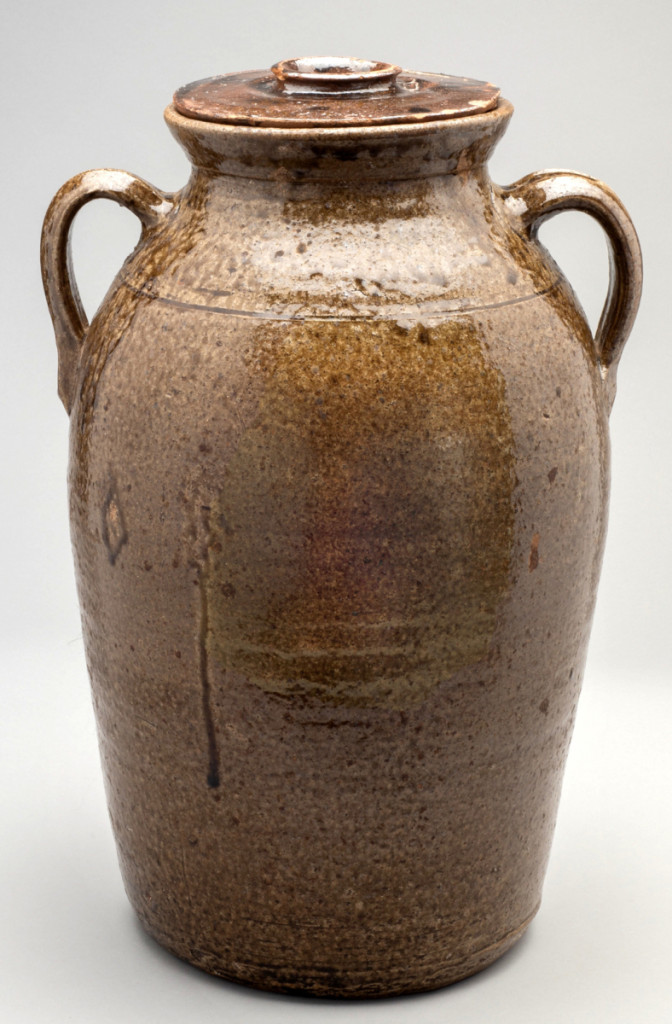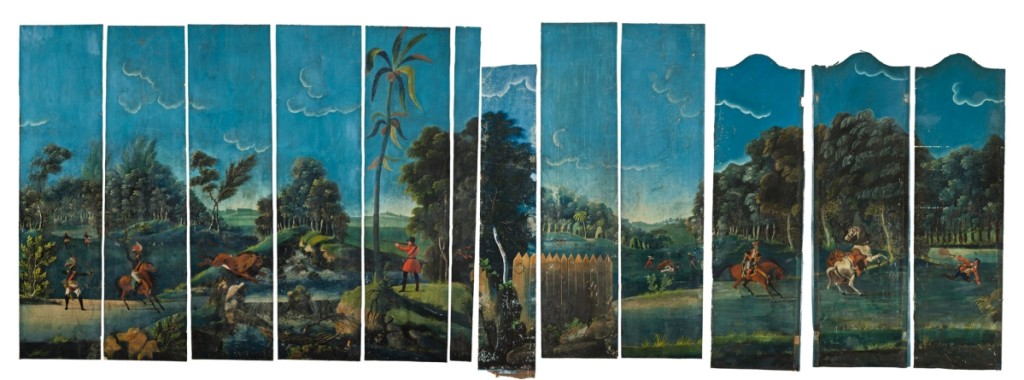
Sugar chest attributed to Stephen H. White (1787-1857), Madison County, Ga., circa 1830-50. Walnut and yellow pine; 24½ by 36 x 17½ inches. Cobbham Collection by William Dunn Wansley.
By Laura Beach
ATHENS, GA. – “I just hate vapid exhibitions. I want a show to say something, do something. It’s important to move scholarship along,” says Dale L. Couch. Passionate advocate and eloquent spokesman, Couch, curator of decorative arts at the Georgia Museum of Art and director of the museum’s Henry D. Green Center for the Study of the Decorative Arts, has been posing provocative questions about art as a tangible expression of the American experience since his boyhood in Aiken, Ga. Over the past decade, the curator, who joined the museum after a long career at the Georgia Archives, has organized a series of milestone exhibitions on Georgia art and design, displays often accompanied by lively symposia.
Couch’s latest effort is the exhibition “Material Georgia 1733-1900: Two Decades of Scholarship,” the subject of a related catalog of the same name. The upcoming Henry D. Green Symposium on the Decorative Arts, titled “Georgia Matters: Celebrating Two Decades of Scholarship,” is set for January 30-February 1. All three initiatives cast a retrospective eye over the evolution of Georgia studies while suggesting directions for future research. There is a celebratory quality to the enterprise, which honors center and symposium, both two decades old, and the curator, who is contemplating retirement.
Couch identifies landmark studies in his field. There was the 1970s survey that culminated in “Missing Pieces: Georgia Folk Art 1770-1976” at the Atlanta Historical Society, later renamed the Atlanta History Center. He credits Deanne Deavours with simultaneously popularizing and saving the state’s vernacular furniture and cites the former Atlanta dealer’s essential contributions to “Neat Pieces: The Plain-Style Furniture of Nineteenth Century Georgia,” organized by the Atlanta Historical Society in 1983. A survey of Georgia decorative arts undertaken by the Colonial Dames of Georgia in the late 1980s resulted in “Hidden Heritage: Recent Discoveries in Georgia Decorative Art, 1733-1915” at the High Museum of Art in 1990 and hastened the documentation of the roughly 5,000 works that form the core of the Green Center collection.
Mounted in the museum’s Philip Henry Alston Jr and Virginia and Alfred Kennedy Galleries, the current presentation arrays a large and varied group of Georgia furniture with an eye toward pinpointing cultural influences, regional styles and singular makers. Rich in silver and formal furniture, the show’s opening gallery features a clutch of pieces from Augusta. Painted furniture, pottery, baskets and other vernacular material are arrayed in a second large gallery, the variety completing a composite portrait of a richly layered society. In all, “Material Georgia” features roughly 100 pieces, with additional silver and objects displayed elsewhere in the museum.
Couch, who was the 2006 recipient of a Georgia Governor’s Award in the Humanities and Arts and was named the 2019 Museum Professional of the Year by the Georgia Association of Museums and Galleries, rejects timeworn assumptions about the South in general and Georgia in particular. “Sure our stuff is distinctive but no more so than what you find in New England. What really hits me about Georgia is how American it is. The state was not formed in a geographic vacuum, nor does it currently exist in one,” he says, adding “We are connected as Georgians to our region and nation, and the scholarship produced under the aegis of the Green Center has recognized that.”
 The curator points to high-style Federal furniture from Augusta, a former trading center that supplied Georgia and South Carolina, as a sophisticated expression of a national aesthetic. Included in the Augusta-area group is an inlaid walnut, birch and pine stage-top sideboard of circa 1800-15. Its probable maker, writes Robert Leath, chief curator and vice president of the Museum of Early Southern Decorative Arts (MESDA), was James Alexander, a Savannah-trained cabinetmaker who established a practice in Augusta, thus transporting Lowcountry design up the Savannah River and into the Georgia Piedmont.
The curator points to high-style Federal furniture from Augusta, a former trading center that supplied Georgia and South Carolina, as a sophisticated expression of a national aesthetic. Included in the Augusta-area group is an inlaid walnut, birch and pine stage-top sideboard of circa 1800-15. Its probable maker, writes Robert Leath, chief curator and vice president of the Museum of Early Southern Decorative Arts (MESDA), was James Alexander, a Savannah-trained cabinetmaker who established a practice in Augusta, thus transporting Lowcountry design up the Savannah River and into the Georgia Piedmont.
“There is a presumed homogeneity within the American South. Nothing could be further from the truth,” says Couch, pleased by the demographic diversity “Material Georgia” achieves. He notes that at the time of the American Revolution at least half of Georgia’s population was foreign-born and relates an 1800-40 Piedmont, Georgia side chair with thick sausage turnings and curvilinear slats to a group with Franco-Germanic associations. “This chair likely represents not only a major addition to the well-established chair group but also indicates that there was a ‘Continentally inclined’ market for them,” the curator writes.
Couch calls for more studies of Georgia portraiture, stressing, “This important aspect of our art history has lain almost dormant since the publication of the Colonial Dames survey Early Georgia Portraits, 1715-1870.” As an enticement, he includes in the display three intriguing paintings of Revolutionary War Captain John Wilson (1756-1847); his wife, Mary Elizabeth Roberson Wilson (1765-1826); and their oldest son David Wilson (1786-1827). By an as yet unidentified artist, the pictures surfaced in the 1980s in a McDuffie County estate among descendants of the sitters. “These brilliant folk portraits point to a gap in the history of Georgia art and decorative art and are rare compared with portraiture in our collection by highly trained artists,” Couch says.
“Little silver was crafted in Georgia after about 1830 because it was replaced by industrially produced goods from the North. Collectors resisted that historical reality and missed the big story that Georgia influenced the national market,” argues Couch, who features an elaborate tea and coffee service made for Augusta mayor Abner P. Robertson around 1854 by Clark & Company, a local firm active in the middle decades of the Nineteenth Century.

Churn, Crawford County, Ga., circa 1890. Stoneware with dripped alkaline glaze; 18 by 12½ inches. Georgia Museum of Art, University of Georgia; gift of Helen Plymale and family.
“Pottery is arguably Georgia’s best-researched and most heavily collected craft expression,” says the curator, who spotlights the Edgefield, S.C., influenced artisan Lucius Jordan (b circa 1818), Georgia’s earliest native-born trained potter of prominence, alternately recorded as a “free man of color” and “white.” Jordan’s work, ceramics historian Brenda Hornsby Heindl notes, “serves as a testament to a community of potters who worked together to further their economic progress and to the diversity of a field often seen as populated by white artisans by the second half of the Nineteenth Century.”
Textiles range from a circa 1770-75 sampler by Mary Smallwood (1761-1791) of Midway, Ga., to a woven coverlet of around 1850-60. It had been the Green Center’s goal to survey Georgia samplers, an ambition realized with the 2015 exhibition “Georgia’s Girlhood Embroideries: ‘Crowned with Glory and Immortality.'” Today the museum owns several rare Georgia examples.
“Material Georgia” illustrates two distinct basketry traditions, one Cherokee, the other Gullah-Geechee. A collection of modern Cherokee baskets forms the core of the Green collection and became the basis for the center’s 2016 show “Cherokee Basketry: Woven Culture.” The earliest basket in the present display is a circa 1830 Cherokee example by an unknown maker active in North Georgia. Woven of river cane, it has oak handles.
Published by the Georgia Museum of Art and distributed by the University of Georgia (UGA), Material Georgia 1733-1900: Two Decades of Scholarship was edited by Couch and includes contributions by Couch and Linda Chesnut, Daniel Chamberlin, Charlotte Crabtree, Ashlyn Davis, Jeff Finch, Jenny Garwood, Brenda Hornsby Heindl, Maryellen Higginbotham, Robert A. Leath, Joseph Litts, Keith M. McCurry, Caroline Rainey, James Rooks and Kathleen Staples. The heavily illustrated volume sells for $60 hardcover.
The vitality of Southern studies is also reflected in the upcoming symposium, which kicks off on Thursday, January 30, with a keynote address by MESDA curator Daniel Ackermann and continues through Saturday, February 1, at the UGA Center for Continuing Education and Hotel. Register by January 21 at https://www.hotel.uga.edu/events/henry-green-symposium-georgia. Visit www.georgiamuseum.org for a full schedule with speakers and topics.

Wallpaper, Columbia County, Ga., 1850-60. Paint on paper, width 71-3/8 inches. The Museum of Early Southern Decorative Arts (MESDA) transferred panels from this set to the Georgia Museum of Art, which is raising money for their conservation.
Couch credits the Georgia Museum of Art’s first curator of decorative arts, Ashley Callahan, with encouraging interest in Twentieth Century Georgia design with such imaginative works as Southern Tufts: The Regional Origins and National Craze for Chenille Fashion (2015), a look at the Southern Appalachian Craft Revival roots of the state’s tufted textile industry, and Georgia Bellflowers: The Furniture of Henry Eugene Thomas (2011), which examines traditional furniture made by Thomas (1883-1965), an antiques dealer and craftsman in Athens, Ga. Still relatively unexplored, modern and contemporary Georgia design will be the focus of the 2022 Green symposium. Couch also looks forward to a day-long program in April 2021 on African American issues and perspectives on the decorative arts. “There is a richness that comes from seeking different voices,” he explains.
As ambitious as it is, “Material Georgia” leaves much undone. “At least half of what remains to be found is still out there. Highly provenanced objects are turning up frequently,” says the curator, eager for the next discovery but pleased to have heightened awareness among the UGA students he regards as society’s next cultural stewards. “We expect and welcome changes in the study of Georgia decorative arts as the academic community shifts to broader questions that respond to the needs of scholarship and society. These objects represent not just ‘art’ but also ‘evidence,'” he writes.
Located on the campus of the University of Georgia, the Georgia Museum of Art is at 90 Carlton Street in Athens. For more information, 706-542-4662 or www.georgiamuseum.org.




















